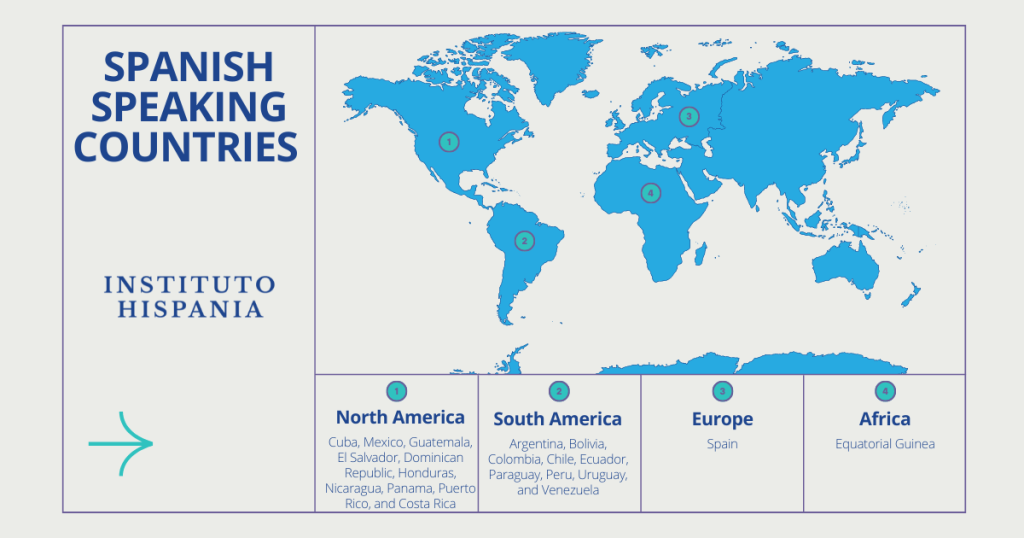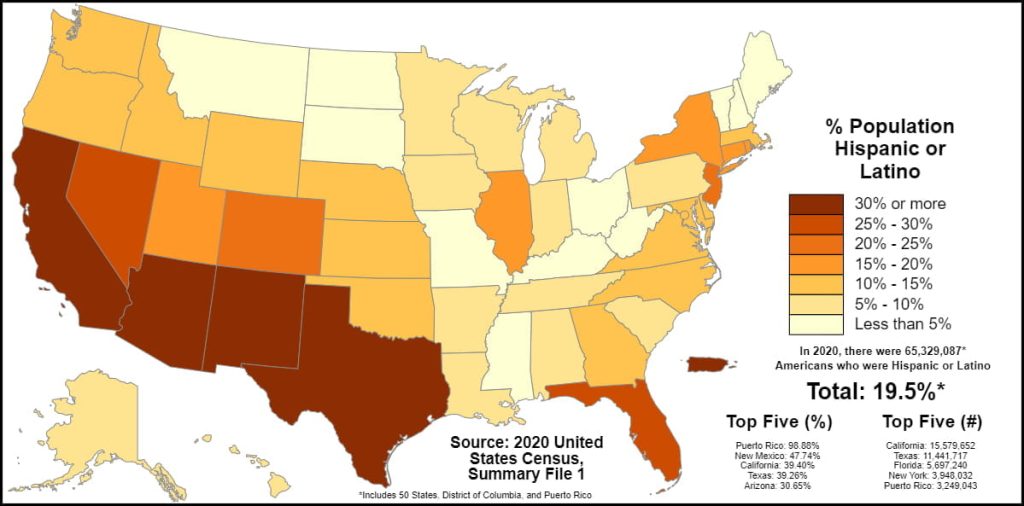They say learning a new language can take you places. But do you know how many countries you can visit when you learn Spanish?
You’re not alone if you’ve decided to learn Spanish for jobs, studies, or hobbies. With over 500 million Spanish speakers, you’re in good company.
The Spanish language is one of the most widely spoken around the globe. Spanish is still very much associated with Spain, where it originated. But it will surprise you that most Spanish speakers live outside this nation.
When you understand how many people know Spanish and where it’s spoken. Then you’ll be able to understand its importance. So let’s find out everything about it.
TABLE OF CONTENTS
- About the Spanish language
- Spanish-Speaking countries — Hispanophone
- Where In The World Is Spanish Spoken?
- Explore the world of Spanish
But first.
About the Spanish language
Spanish (Español) is a Romance language from Spain’s Castille region. This is why it is called Castilian, mainly in Latin America.
We know it as the Iberian Romance language because of its place of origin. Catalan, Galician, and Portuguese are some other languages that belong to this sub-language family.
Latin is the root of the Spanish language. After the Roman conquest in the 2nd and 3rd centuries BC, it arrived on the Iberian Peninsula.
During the 13th century, King Alfonso made the Castilian variant the official language of the government administration. Since then, it has remained a primary language in this region till today.
In terms of size, the Spanish Empire was one of the biggest empires in history. It colonized a vast area of North, Central, and South America. That is why many people speak Spanish on these two continents.
Spanish-Speaking countries — Hispanophone

There is an extensive spread of Spanish across the globe. You can find plenty of Spanish-speaking people from the Philippines to Spain to the US to Peru.
According to a recent study by Cervantes, there are 493 million native Spanish speakers globally. The total number rises to 591 million once we add those who speak it as a foreign language or have good competency.
In short, there are nearly 600 million Spanish speakers worldwide, making up 7.5% of the total world population. It is also the third-most spoken mother tongue, after Mandarin and Hindi.
3rd most taught language in the world
Roughly 24 million students are learning Spanish as a foreign language. This pushes it into the third most-studied language globally, after English and French.
No matter your reasons for studying Spanish and where you live, you can find many chances to learn this beautiful tongue. Moreover, it is easily accessible with a ton of resources.
The official status of the Spanish language
Spanish (also known as Castellano) is the only official language of entire Spain. It is also the mother tongue of the vast majority of the Spanish population.
Twenty sovereign countries (by law/de jure or de facto) have declared Spanish their official language. Puerto Rico, a US-dependent territory, also uses it as its official language.
Spanish is the official language of dozens of international organizations. It includes the United Nations (UN), Organization of American States, World Trade Organization (WTO), Organization for Security and Co-operation in Europe (OSCE), African Union, etc.
Spanish has official and legal status in 20 Hispanic nations and 1 US territory. Here is the list of 21 official Spanish-speaking countries.
Argentina, Bolivia, Chile, Colombia, Cuba, Costa Rica, Dominican Republic, Ecuador, El Salvador, Equatorial Guinea, Guatemala, Honduras, Nicaragua, Puerto Rico, Mexico, Peru, Panama, Paraguay, Spain, Uruguay, and Venezuela.
Spanish continues to have political influence or is valuable in many places. For instance, territories such as the USA, Philippines, Morocco, Belize, and France, to name a few.
Where In The World Is Spanish Spoken?
Spanish is everywhere, across cities, countries, and continents. The Hispanic world is massive and ever-growing.
There are many regions all over the globe where Spanish is widely spoken. So let’s get into it!
1. Spanish speakers in Europe
Spain’s five official languages are Spanish, Catalan, Galician, Basque, and Aranese.
Spain is a multi-language country. Yet nearly 95% of the population of Spain speaks Spanish (also known as Castellano) as a mother tongue or second language, despite diverse languages.

Andorra, though a small country, has 40% Spanish speakers. Gibraltar, a British Overseas Territory in the Iberian Peninsula, has many bilinguals who speak Spanish.
Spanish is the sixth most commonly used language in Europe after Russian, German, French, English, and Italian. With 46 million speakers, it is a helpful language in Europe.
Other nations in Europe
Spanish isn’t widely spoken or holds official status in other European regions. But, it has active communities of native speakers in dozens of nations.
This includes France, Portugal, Italy, Denmark, Netherlands, Switzerland, Sweden, the UK, Ireland, Romania, Belgium, Germany, Austria, Finland, etc.
The Spanish-speaking folk in these places range from 2% to 10%. Also, one can find native speakers in nearly every European nation, even if the percentage is small.
In the European Union, Spanish is one of 24 official languages.
2. Spanish speakers in North America
In North America, Spanish is famous across two major countries. The United States has many Spanish speakers, but it is not an approved language.
Mexico is the only country that uses Spanish as its national language in the region. Many immigrants from Spain and Latin America speak Spanish in Canada.
Spanish Speaking population in the USA
Spanish, like English, does not have official status in the USA. Still, it has notable native and bilingual Spanish speakers.

Around 42 million people in the US speak Spanish as their aboriginal language as of 2023, making up 13% of the total population. Further, the US is home to about 12 million bilingual Spanish speakers.
Overall, roughly 54 million Spanish speakers are in the USA. So it has more Spanish speakers than Spain and Colombia. As a result, it is the second-largest Spanish-speaking country after Mexico.
Spanish is also the most commonly taught language in the US. So, per the increasing number of Spanish students and Hispanic ethnic groups, we only expect the number to grow.
The US Census office expects 138 million Spanish speakers by 2050. This can make the US the world’s biggest Spanish-speaking nation.
How many people speak Spanish in Mexico?
Mexico has the most significant number of native Spanish-speaking citizens in the world. It has twice as many Spanish speakers as Spain.
The Mexican Government identifies 68 national languages, including 63 indigenous, and hundreds of their dialects. This makes it diverse in languages.
Nearly 90% of the population spoke yet Spanish. As of 2023, around 125 million people in Mexico speak Spanish as their mother tongue or second language.
3. Spanish speakers in Central America
There is a significant Spanish-speaking population across the seven countries of Central America.
Except for Belize, all six nations, i.e., Guatemala, El Salvador, Honduras, Nicaragua, Panama, and Costa Rica, have Spanish status as “de jure.”

90% to 99% of the population of these countries speak Spanish as a first or second language. Also, almost half of its population can speak Spanish in Belize.
So, about 170 million of the total 182 million living in Central America communicate in Spanish.
Central America is the only place where Spanish is always spoken across borders. So naturally, this is a joy for Spanish language lovers.
4. Spanish speakers in the Caribbean
There are dozens of independent nations and overseas territories in the Caribbean region. But Spanish isn’t a common language here.
Only three islands (Cuba, Dominican Republic, and Puerto Rico) use Spanish as an authorized language. While the two are independent, Puerto Rico is a territory of the US.
Spanish is also beneficial in the Bay Islands (Honduras), Corn Islands (Nicaragua), Nueva Esparta (Venezuela), Isla Cozumel and Isla Mujeres (Mexico), and San Andrés and Santa Catalina (Colombia).
5. Spanish speakers in South America
Of the 10 countries with a significant population, Spanish is the official language of 9 countries. This includes Argentina, Bolivia, Colombia, Chile, Ecuador, Paraguay, Peru, Uruguay, and Venezuela.

Spanish is a dominant language across 9 countries. Yet, indigenous and local languages like Quechua, Guarani, and Aymara are helpful in some areas, along with Spanish.
There are also wide varieties and dialects of Spanish. As an outcome, learners may get caught up in struggles to remember new words, phrases, and even pronunciations. Still, it is pretty much all Spanish!
Spanish is not much favored in Brazil as Portuguese is the country’s only official language. But since Portuguese are like Spanish. Hence, your Spanish skills help you understand a few things quickly.
Like Portuguese, Spanish is spoken by nearly half of the South American population.
6. Spanish speakers in Africa
Unlikeisn’tcountries of the Western Hemisphere, Africa does not have many Spanish-speaking citizens.
Equatorial Guinea (República de Guinea Ecuatorial) is the only African country with an impressive number. This is because this has been the official and national language since 1944.
Equatoguinean Spanish, a regional variant of Spanish, is the lingua franca of the diverse ethnic group of the country. Close to 70% of the habitants speak Spanish, and most are fluent, especially around the capital, Malabo.
It shares many resemblances with the Spanish of Spain and Latin America. Yet it differs vastly in accents, words, and expressions.
This resulted from the country’s geographical isolation. Also, the influence of German, Portuguese, French, and other local languages impacted over the last few centuries.
There are also several Spanish-speaking people in Morocco and Western Sahara. Again, it is due to its history and close location.
So these are a few places in Africa where you can test your Spanish language skills.
6. Spanish speakers in Asia
Spanish isn’t widespread in Asia, and it never was actually.
In the 16th century, Spanish explorers extended their footprints and colonized the Philippines.
Until 1973, Spanish was the official language of the Government. Thus, it has historically been a more widely understood language here.
While Filipino is the official and most widely spoken language, many also speak Spanish as a second or third language.
Filipino and hundreds of indigenous languages form thousands of Spanish loanwords. E.g., Spanish is the source of about 20% to 30% of words in Tagalog. Spanish orthography has notably influenced the spelling system in most of these languages.
Today, approximately 1 million people speak Chavacano, a Spanish-based creole developed in the Philippines. Many schools also teach Spanish.
Beyond the Philippines, there aren’t a considerable number of Spanish speakers. Most of them are learners. They studied and gained proficiency and certifications like Spanish DELE and SIELE.
Explore the world of Spanish

I hope this blog inspired you to learn Spanish or to continue learning it. Knowing all the places, Spanish can take you places.
So what’s holding you back from diving into your next Spanish lesson?
If you’re interested in Spanish classes in India, check out Instituto Hispania courses designed per the DELE, DIE, telc, and SIELE exams.
And if you can’t get enough of Spanish and want to learn more now, check out our other blog posts. It can surely help you explore an intriguing world of everything Spanish.
Do you wish to share your thoughts on this topic? Write in the comment below.








